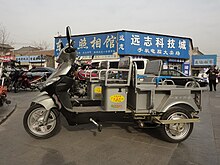|
Electric rickshaw
Electric rickshaws (also known as electric tuk-tuks,[1] e-rickshaws,[2] Totos[3] and e-tricycles[4]) are small three-wheeled vehicles powered by an electric battery and motor. These small electric vehicles do not require petroleum fuel like auto rickshaws but still offer greater mobility than traditional cycle rickshaws and pulled rickshaws. This has led to their popularity and use expanding in some cities since 2008.[citation needed] Electric rickshaws are primarily manufactured in India, Bangladesh, Nepal, and China.[5][6]   Development of the E-Rickshaw market in India Share of productionDuring 2020–23, the registration of e-rickshaws saw a significant increase, with around 300,000 vehicles registration in 2022–23, up from 78,700 in 2020–21.[7] Although a host of unorganised producers dominate this segment, established manufacturers have also identified their growth opportunities and are expected to enter into the segment.[8]  Sales trendsIn the early 2010s, E-Rickshaws were introduced to several Indian and Chinese cities, however, they sold poorly at first and were initially uncommon. Driven by a push for more environmentally friendly methods of transportation, the electric rickshaw has surged in popularity, and takes up an increasingly larger share of urban transport in these areas, especially as already established companies introduce their rickshaw products to the market.[8][9] Design and construction Electric rickshaws usually have a mild steel tubular chassis, consisting of three wheels with a Differential mechanism sending power to the rear wheels. The motor is a brushless DC motor, with power outputs generally ranging from 650 to 1,400 watts (0.87 to 1.88 hp). The electrical system used in Indian versions is 48V and in Bangladesh is 60V. In China, the most popular body design is made of very thin iron or aluminium sheets. Bodies made of fiberglass are also popular for their strength and durability resulting in low maintenance requirements.[10] The vehicle's batteries are typically lead acid with a lifespan of 6 to 12 months. Deep-cycle batteries designed for electric vehicles are rarely used.[11] Types Load carriersThe load-carrying versions of these rickshaws differ in their upper body, load-carrying capacity, motor power, controllers, and other structural aspects. At times, the motor power is also increased to carry loads up to 500–1,000 kg.[citation needed] Solar
There are two types of solar vehicles:
PopularityElectric rickshaws are most popular in Asia, especially in China, India, Bangladesh, and Nepal. Low-cost Chinese models were the often first electric rickshaws to become popular in those countries. In addition to this, China, Japan, India, and European countries (Switzerland, France, and Germany) have researched and developed electric tricycles for commercial transport and are attempting to enter the growing market in Asia. BangladeshBangladesh began importing electric rickshaws in 2004, from China. In May 2011, the government banned the import and assembly of the vehicles and ordered operating vehicles to be scrapped, because most are recharged through illegal connections. Importers said they would challenge the ban in court.[13] In 2021, the government again announced a ban, citing road safety.[14] China China is the largest manufacturer of electric rickshaws in the world, largely due to low labour costs, high production rates, and government incentives encouraging foreign trade, they import a large number daily. There are hundreds of electric rickshaw manufacturers and thousands of parts producers. Their main market is within small towns or cities with insufficient public transport.[6] NepalElectric Rickshaws "Citi Safaris" are seeming popular among the Nepalese Community. It has been in use for several of regions in various regions of Nepal including Dharan and Biratnagar. This cheap method of transportation has revolutionized the transport sector in Nepal. Being eco-friendly, it has also helped Nepal reduce pollution to an extent. IndiaOne of the first attempts to design electric rickshaws was by the Nimbkar Agricultural Research Institute in the late 1990s.[15][16] Today, e-rickshaws play a major role in providing livelihoods to people in India, as their low cost and high efficiency make them common on Indian streets.[17] Government policies have threatened the e-rickshaw and banned its use in the capital city Delhi,[17][18] However, these measures did not lead to a national ban, and e-rickshaws were legalized in India in 2015. E-rickshaws are still rising in number and are widely used in Delhi and other parts of India. In Delhi, as per official government figures in April 2012, their number was over 100,000.[6][19]  E-rickshaw law in IndiaInitially, e-rickshaws were unregulated by any central law in India. However, the Delhi High Court banned the running of e-rickshaws in Delhi on 31 July 2014 over safety concerns raised through public interest litigation.[20] In a rally held for the regularization of e-rickshaws in Delhi, transport minister Nitin Gadkari said that municipal corporations would regularize e-rickshaws by registering them for a fee of just ₹100. After registering the e-rickshaw, corporations will have to issue identity cards to drivers so that they can earn their livelihoods easily."[21] Once the policy was in place, the corporation, along with traffic police, would have determined the amount of the fine to be imposed for violation of the policy.[21] However, the policy was never implemented. Certain states like Tripura have regulated the e-rickshaws through municipal bylaws or state legislation.[20] In March 2015, the Indian Parliament passed an amendment to the Motor Vehicles (Amendment) Bill, 2015 legalizing e-rickshaws.[22] By July 2015, battery rickshaws were available in many cities and were required to comply with registration number plates by R.T.O. with insurance. Potential marketThe global electric rickshaw market was valued at approximately US$1.55 billion in 2023 and is expected to grow at a compound annual growth rate (CAGR) of 14.9% to reach US$4.11 billion by 2030.[23] See alsoReferences
|